![]()
![]()
![]()
Use LEFT and RIGHT arrow keys to navigate between flashcards;
Use UP and DOWN arrow keys to flip the card;
H to show hint;
A reads text to speech;
82 Cards in this Set
- Front
- Back
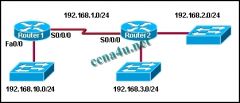
Refer to the exhibit. The network that is shown is running RIPv1. The 192.168.10.0/24 network was recently added and will only contain end users. What command or set of commands should be entered on Router1 to prevent RIPv1 updates from being sent to the end user devices on the new network while still allowing this new network to be advertised to other routers?
a. Router1(config-router)# no router rip Router1(config-router)# network 192.168.10.0 b. Router1(config-router)# no network 192.168.10.0 c. Router1(config-router)# passive-interface fastethernet 0/0 d. Router1(config-router)# passive-interface serial 0/0/0 |
c. Router1(config-router)# passive-interface fastethernet 0/0
|
|
|
Refer to the output from the show ip route command. What can be concluded from the output of this router command?
a. A preferred route to the destination has not been set. b. There are two equal cost paths to network 1.0.0.0. c. Both interfaces are being used equally to route traffic. d. A variance must be set to load-balance across multiple paths. |
b. There are two equal cost paths to network 1.0.0.0.
|
|
|
Refer to the exhibit. The Ethernet interface on Router2 goes down and the administrator notices that the route is still in the Router1 routing table. How much longer will Router1 keep the down network in its routing table before marking it as possibly down?
a. 30 seconds b. 90 seconds c. 155 seconds d. 180 seconds e. 255 seconds |
c. 155 seconds
|
|
|
What is the default update period in seconds for the RIP routing protocol?
a. 10 b. 12 c. 15 d. 20 e. 30 f. 60 |
e. 30
|
|
|
Which of the following is considered a limitation of RIP v1?
a. RIP v1 does not send subnet mask information in its updates. b. RIP v1 is not widely supported by networking hardware vendors. c. RIP v1 consumes excessive bandwidth by multicasting routing updates using a Class D address. d. RIP v1 requires enhanced router processors and extra RAM to function effectively. e. RIP v1 does not support load balancing across equal-cost paths. f. RIP v1 authentication is complicated and time-consuming to configure. |
a. RIP v1 does not send subnet mask information in its updates.
|
|
|
Which command will display RIP activity as it occurs on a router?
a. debug ip rip b. show ip route c. show ip interface d. show ip protocols e. debug ip rip config f. show ip rip database |
a. debug ip rip
|
|
|
What are three characteristics of the RIPv1 routing protocol? (Choose three.)
a. supports the use of VLSM b. uses hop count as a metric c. considers a metric of 16 as infinity d. has an administrative distance of 110 by default e. includes the destination IP address and subnet mask in routing updates f. calculates metrics using the Bellman Ford algorithm |
b. uses hop count as a metric
c. considers a metric of 16 as infinity f. calculates metrics using the Bellman Ford algorithm |
|
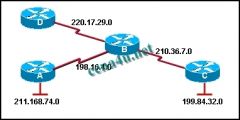
Which of the following would be the correct command sequence to enable RIP on Router B for all connected networks?
a. RouterB# router rip RouterB(router)# network 210.36.7.0 RouterB(router)# network 220.17.29.0 RouterB(router)# network 211.168.74.0 b. RouterB(config)# router rip RouterB(config-router)# network 198.16.4.0 RouterB(config-router)# network 211.168.74.0 RouterB(config-router)# network 199.84.32.0 c. RouterB(config)# configure router rip RouterB(config-router)# network 210.36.7.0 RouterB(config-router)# network 199.84.32.0 RouterB(config-router)# network 211.168.74.0 d. RouterB(config)# router rip RouterB(config-router)# network 198.16.4.0 RouterB(config-router)# network 210.36.7.0 RouterB(config-router)# network 211.168.74.0 e. RouterB(config)# router rip RouterB(config-router)# network 198.16.4.0 RouterB(config-router)# network 210.36.7.0 RouterB(config-router)# network 220.17.29.0 |
e. RouterB(config)# router rip
RouterB(config-router)# network 198.16.4.0 RouterB(config-router)# network 210.36.7.0 RouterB(config-router)# network 220.17.29.0 |
|

Refer to the exhibit. All routers are configured with valid interface addresses in the indicated networks and are running RIPv1. The network is converged. Which routes are present in the routing tables?
a. All routers have all routes in their routing table. b. All routers have all /30 routes, but do not have /24 routes in their routing table. c. All routers have all /30 routes. Routers A and E also have some of the /24 routes in their routing table. d. All routers have all /30 routes. Routers B and D also have some of the /24 routes in their routing table. e. Routers A and E have all routes. Routers B and D have only /30 routes in their routing table. f. Routers A and E have only /24 routes. Routers B and D have only /30 routes in their routing table. |
c. All routers have all /30 routes. Routers A and E also have some of the /24 routes in their routing table.
|
|
|
What will happen if an interface IP address is entered for the address portion of the network command in a RIPv1 configuration instead of a network address?
a. The router will reject the command. b. A route to the host address will be added to outgoing RIP updates. c. A route to the host address will be added to the routing table. d. All interfaces in the same classful network as the configured address will be included in the RIPv1 routing process. |
d. All interfaces in the same classful network as the configured address will be included in the RIPv1 routing process.
|
|

Refer to the exhibit. Router1 and Router2 are running the RIPv1 protocol. The network administrator configures the command network 10.1.0.0 on Router1. What network will Router1 advertise to Router2?
a. 10.1.0.0/16 b. 10.1.0.0/8 c. 10.0.0.0/16 d. 10.0.0.0/8 |
d. 10.0.0.0/8
|
|

Refer to the exhibit. All routers in the exhibit are running RIP v1. The network administrator issues the show ip route command on router A. What routes would appear in the routing table output if the network is converged? (Choose two).
a. R 192.168.2.0/24 [120/1] b. C 192.168.2.0/24 [120/1] c. R 10.10.3.0/24 [120/0] d. C 10.10.3.0/24 [120/1] e. R 10.10.1.0/24 [120/2] f. R 10.10.1.0/24 [120/3] |
a. R 192.168.2.0/24 [120/1]
e. R 10.10.1.0/24 [120/2] |
|
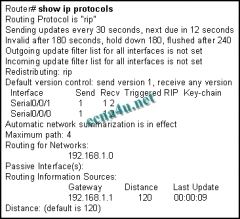
Refer to the exhibit. A network consists of multiple routers. What can be verified when the show ip protocols command is issued on one of the routers in the network?
a. whether all routes in the network have been properly added to the routing table b. routing protocol configuration in use for IP on this router c. operational status of routing protocols in use on all routers in the network d. routing metric of each network that is listed in the routing table |
b. routing protocol configuration in use for IP on this router
|
|
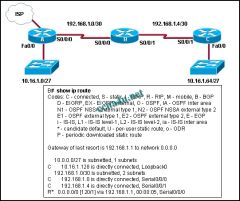
Refer to the exhibit. What can be concluded from the routing table output of router B?
a. A static default route has been configured on B. b. The default-information originate command has been entered on A. c. All traffic that is destined for 192.168.1.1 will be sent to address 0.0.0.0. d. Hosts on the 10.16.1.0/27 network have 192.168.1.1 configured as the default gateway address. |
b. The default-information originate command has been entered on A.
|
|
|
The following line was displayed in the output of the show ip route command. R 192.168.3.0/24 [120/3] via 192.168.2.2, 00:00:30, Serial0/0 What is the value of the routing metric?
a. 3 b. 12 c. 20 d. 30 e. 120 |
a. 3
|
|
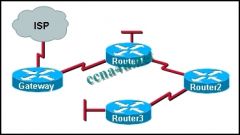
Refer to the exhibit. All routers that are shown are running the RIP routing protocol. All unknown IP traffic must be forwarded to the ISP. What router or set of routers are recommended to have both a default route and the default-information originatecommand issued to implement this forwarding policy?
a. only Router1 b. only the gateway router c. all routers in the network d. only the routers with LANs needing Internet access |
b. only the gateway router
|
|

Refer to the exhibit. Router1 is running RIPv1. What command was entered into Router1 to configure the gateway of last resort?
a. no auto-summary b. ip default-network 0.0.0.0 c. ip default-gateway 10.0.0.0 d. ip route 0.0.0.0 0.0.0.0 S0/0/1 |
d. ip route 0.0.0.0 0.0.0.0 S0/0/1
|
|
|
Which command or set of commands will stop the RIP routing process?
a. RouterB(config)# router rip RouterB(config-router)# shutdown b. RouterB(config)# router rip RouterB(config-router)# network no 192.168.2.0 c. RouterB(config)# no router rip d. RouterB(config)# router no rip |
c. RouterB(config)# no router rip
|
|
|
Which two statements are true regarding the characteristics of RIPv1? (Choose two).
a. It is a distance vector routing protocol. b. It advertises the address and subnet mask for routes in routing updates. c. The data portion of a RIP message is encapsulated into a TCP segment. d. The data portion of a RIP message is encapsulated into a UDP segment. e. It broadcasts updates every 15 seconds. f. It allows a maximum of 15 routers in the routing domain. |
a. It is a distance vector routing protocol.
d. The data portion of a RIP message is encapsulated into a UDP segment. |
|
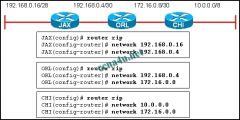
Refer to the exhibit. RIPv1 is running on all three routers. All interfaces have been correctly configured with addresses in the address ranges that are shown. Which route would you see in the routing table on router CHI if the routers are configured with the commands that are displayed in the exhibit?
a. 192.168.0.4/30 b. 192.168.0.0/24 c. 192.168.0.0/16 d. 192.168.0.32/27 |
b. 192.168.0.0/24
|
|
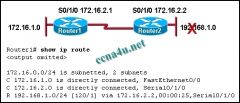
Refer to the exhibit. The Ethernet interface on Router2 goes down and the administrator notices that the route is still valid in the routing table of Router1. How much longer will it take for Router1 to mark the route invalid by setting the metric to 16?
a. 30 seconds b. 90 seconds c. 155 seconds d. 180 seconds e. 255 seconds |
c. 155 seconds
|
|
|
What two advantages does CIDR provide to a network? (Choose two.)
a. reduced routing table size b. dynamic address assignment c. automatic route redistribution d. reduced routing update traffic e. automatic summarization at classful boundaries |
a. reduced routing table size
d. reduced routing update traffic |
|
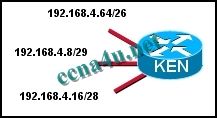
Refer to the exhibit. Which address is a broadcast address for one of the subnets that are shown in the exhibit?
a. 192.168.4.3/29 b. 192.168.4.15/29 c. 192.168.4.65/26 d. 192.168.4.255/24 |
b. 192.168.4.15/29
|
|
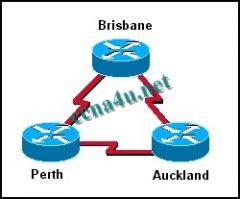
In the network shown in the graphic, three bits were borrowed from the host portion of a Class C address. How many valid host addresses will be unused on the three point-to-point links combined if VLSM is not used?
a. 3 b. 4 c. 12 d. 36 e. 84 f. 180 |
e. 84
|
|
|
Which of the following are contained in the routing updates of classless routing protocols? (Choose two.)
a. 32-bit address b. next hop router interface c. subnet mask d. unicast host address e. Layer 2 address |
a. 32-bit address
c. subnet mask |
|

Refer to the exhibit. The network administrator wants to create a subnet for the point-to-point connection between the two routers. Which subnetwork mask would provide enough addresses for the point-to-point link with the least number of wasted addresses?
a. 255.255.255.192 b. 255.255.255.224 c. 255.255.255.240 d. 255.255.255.248 e. 255.255.255.252 |
e. 255.255.255.252
|
|
|
What does VLSM allow a network administrator to do?
a. utilize one subnet mask throughout an autonomous system b. utilize multiple subnet masks in the same IP address space c. utilize IGRP as the routing protocol in an entire autonomous system d. utilize multiple routing protocols within an autonomous system |
b. utilize multiple subnet masks in the same IP address space
|
|
|
Which three interior routing protocols support VLSM? (Choose three.)
a. OSPF b. RIP v1 c. RIP v2 d. EIGRP e. BGP f. STP |
a. OSPF
c. RIP v2 d. EIGRP |
|
|
Which of the following problems does VLSM help to alleviate?
a. the shortage of IP addresses b. the difficulty of assigning static IP addresses to hosts in large enterprises c. the complexity of implementing advanced routing protocols such as OSPF and EIGRP d. the shortage of network administrators qualified in the use of RIP v1 and IGRP |
a. the shortage of IP addresses
|
|
|
Refer to the exhibit. A network technician enters the static route in R1 needed to reach network 10.1.1.0/24. A ping from the S0/0/0 interface on R1 to host B fails. The technician begins testing the network and has the following results:
1. pings from R1 to the S0/0/0 interface on R2….successful 2. pings from R1 to the Fa0/0 interface on R2….successful 3. pings from host B to hosts on the 10.1.1.0/24 network….successful 4. pings from host B to the Fa0/0 interface on R2….successful 5. pings from R2 to host B….successful. What is the likely cause of the failure of the ping from R1 to host B? a. The default gateway on host B is not correctly set. b. There are no routes back to networks connected to R1 from R2. c. There is a Layer 2 problem between R2 and host B. Host B has a defective Ethernet card. |
a. The default gateway on host B is not correctly set.
|
|
|
A network administrator is tasked with dividing up a class C network among the QA, Sales, and Administration departments. The QA department is made up of 10 people, the Sales is made up of 28 people, and the Administration has 6. Which two subnets masks adequately address the QA and Sales departments? (Choose two.)
a. 255.255.255.252 for QA b. 255.255.255.224 for Sales c. 255.255.255.240 for QA d. 255.255.255.248 for QA e. 255.255.255.0 for Sales |
b. 255.255.255.224 for Sales
c. 255.255.255.240 for QA |
|

Refer to the exhibit. A network engineer is summarizing the two groups of routes on router R1 shown in the exhibit. Which summarization will work for all the subnets?
a. 192.168.0.0/23 b. 192.168.0.0/22 c. 192.168.0.0/21 d. 192.168.0.0/20 |
c. 192.168.0.0/21
|
|
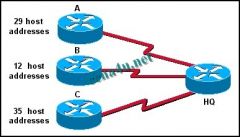
A Class C address has been assigned for use in the network shown in the graphic. Using VLSM, which bit mask should be used to provide for the number of host addresses required on Router A, while wasting the fewest addresses?
a. /31 b. /30 c. /29 d. /28 e. /27 f. /26 |
e. /27
|
|

Refer to the exhibit. In the network that is shown, the router interfaces are assigned the first address in each subnet. Which IP address would be usable for a host on one of the LANs in this network?
a. 192.168.1.5/30 b. 192.168.2.17/28 c. 192.168.2.63/27 d. 192.168.2.130/25 |
d. 192.168.2.130/25
|
|
|
Refer to the exhibit. What subnet mask will be applied if Router A sends a RIPv1 update for the network 172.16.1.0 to Router B?
a. none b. 8 c. 16 d. 24 |
d. 24
|
|

Refer to the exhibit. The number of required host addresses for each subnet in a network is listed in the exhibit. This number includes the host address requirements for all router ports and hosts on that subnet. After all device and router port address assignments are determined, what will be the total number of unused host addresses available?
a. 6 b. 14 c. 29 d. 34 e. 40 f. 62 |
c. 29
|
|
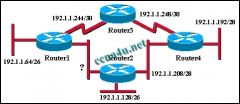
An additional subnet is required for a new Ethernet link between Router1 and Router2 as shown in the diagram. Which of the following subnet addresses can be configured in this network to provide a maximum of 14 useable addresses for this link while wasting the fewest addresses?
a. 192.1.1.16/26 b. 192.1.1.96/28 c. 192.1.1.160/28 d. 192.1.1.196/27 e. 192.1.1.224/28 f. 192.1.1.240/28 |
e. 192.1.1.224/28
|
|
|
What is a supernet?
a. the network for a default route b. a summarization of classful addresses c. a network that contains both private and public addresses d. a set of discontiguous networks that are controlled by an ISP |
b. a summarization of classful addresses
|
|

Refer to the exhibit. A network administrator needs to create two subnetworks from 10.0.0.0/8 for a router running RIPv2. The Admin subnet requires 120 hosts and the Sales subnet requires 58 hosts. The network administrator assigned 10.0.1.128/25 to the Admin subnet. The Sales subnet is given 10.0.1.192/26. What will be the result of this addressing scheme?
a. Because RIPv2 does not support VLSM, the subnet masks will not be allowed. b. The subnets will not have enough host addresses for the given network requirements. c. The subnets overlap and will be rejected by the router. d. The router will support the addressing scheme. |
c. The subnets overlap and will be rejected by the router.
|
|
|
A router has a summary route to network 192.168.32.0/20 installed in its routing table. What range of networks are summarized by this route?
a. 192.168.0.0 – 192.168.32.0/24 b. 192.168.0.0 – 192.168.47.0/24 c. 192.168.32.0 – 192.168.47.0/24 d. 192.168.32.0 – 192.168.48.0/24 e. 192.168.32.0 – 192.168.63.0/24 |
c. 192.168.32.0 – 192.168.47.0/24
|
|
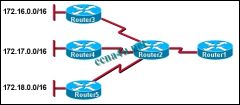
Refer to the exhibit. The network administrator wants to minimize the number of entries in Router1’s routing table. What should the administrator implement on the network?
a. VLSM b. CIDR c. private IP addresses d. classful routing |
b. CIDR
|
|

Refer to the exhibit. What subnet mask will be applied by router B when it receives a RIPv1 update for the network 172.16.1.0?
a. none b. 8 c. 16 d. 24 |
c. 16
|
|
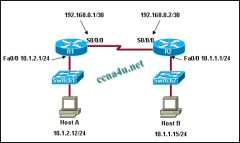
Refer to the exhibit. A network technician enters the static route in R1 needed to reach network 10.1.1.0/24. A ping from R1 to Host B fails. The technician begins testing the network and has the following results:
1. pings from R1 to the S0/0/0 interface on R2….successful 2. pings from R1 to the Fa0/0 interface on R2….successful 3. pings from Host B to hosts on the 10.1.1.0/24 network….successful 4. pings from Host B to the Fa0/0 interface on R2….successful 5. pings from R2 to Host B….successful What is the likely cause of the failure of the ping from R1 to Host B? a. Host B has a defective Ethernet card. b. The default gateway on Host B is not correctly set. c. There is a Layer 2 problem between R2 and Host B. d. R2 does not have routes back to networks connected to R1. |
b. The default gateway on Host B is not correctly set.
|
|
|
A network administrator has been told that the company IP address infrastructure must adhere to RFC 1918. What three IP address ranges from RFC 1918 could the administrator use on the network? (Choose three.)
a. 10.0.0.0/8 b. 127.0.0.0/8 c. 169.254.0.0/16 d. 172.16.0.0/12 e. 192.168.0.0/16 f. 209.165.201.0/27 |
a. 10.0.0.0/8
d. 172.16.0.0/12 e. 192.168.0.0/16 |
|
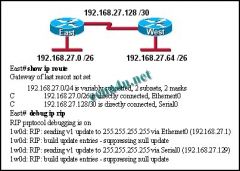
Refer to the exhibit. Routers East and West are configured using RIPv1. Both routers are sending updates about their directly connected routes. The East router can ping the West router serial interface and West can ping the serial interface of East. However, neither router has dynamically learned routes from the other. What is most likely the problem?
a. A gateway of last resort is required. b. Subnetting is not supported by RIPv1. c. VLSM is not supported by RIPv1. d. One of the routers needs a clock rate on the serial interface. |
c. VLSM is not supported by RIPv1.
|
|

Refer to the exhibit. What effect will the commands that are shown have on RIP updates for Router1?
a. Only version 2 updates are sent to 255.255.255.255. b. Only version 2 updates are sent to 224.0.0.9. c. Both version 1 and version 2 updates are sent to 224.0.0.9. d. Both version 1 and version 2 updates are sent to 255.255.255.255. |
b. Only version 2 updates are sent to 224.0.0.9.
|
|
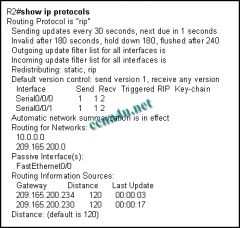
Refer to the exhibit. What can be concluded from the output shown in the exhibit?
a. The routing table is limited to 2 routes. b. The LAN interfaces are participating in the routing process. c. One update has been sent out of each serial interface and 2 have been received. d. The no auto-summary has not been configured on this router. |
d. The no auto-summary has not been configured on this router.
|
|
|
What are two reasons to implement RIP version 2 rather than RIP version 1? (Choose two.)
a. RIP version 2 supports VLSM. b. RIP version 2 supports more than 16 routers. c. RIP version 2 supports classful (and not classless) routing. d. RIP version 2 supports routing update authentication. e. RIP version 2 supports multi-areas. f. RIP version 2 uses the Dijkstra algorithm rather than the Bellman-Ford algorithm. |
a. RIP version 2 supports VLSM.
d. RIP version 2 supports routing update authentication. |
|

Refer to the exhibit. RIPv1 is configured as the routing protocol for the network that is shown. The following commands are used on each router:
router rip network 10.0.0.0 network 172.16.0.0 When this configuration is complete, users on the LAN of each router are unable to access the remote LANs. Why? a. The network statements are configured incorrectly. b. A routing loop has been created. c. RIPv1 is unable to route to discontiguous subnets of a major network. d. RIPv1 is unable to route networks with a /24 subnet mask. |
c. RIPv1 is unable to route to discontiguous subnets of a major network.
|
|
|
A network administrator installed four new routers that are running RIPv2. Router1 is a boundary router in the RIPv2 network and has a default route configured. Once the network has converged, the network administrator enters Router1(config-router)# default-information originate on Router1. How will this affect the network?
a. prevents Router1 from forwarding updates about networks that are not directly connected b. causes all routers in the network to synchronize routing updates with Router1 c. forces Router1 to become the primary or designated router (DR) for updates d. propagates the default route to all routers in the network |
d. propagates the default route to all routers in the network
|
|

Refer to the exhibit. A technician needs to add a new loopback interface to test routing functionality and network design. The technician enters the following set of commands on the router:
Sanford(config)# interface loopback1 Sanford(config-if)# ip address 192.168.6.62 255.255.255.252 Why does the router respond with an error? a. The router does not allow loopback interface configurations. b. This mask can not be used with this class of addresses. c. Classless routing must be configured before this address can be added. d. The network address for Loopback1 overlaps with an already configured interface address. e. The router is over the limit for the maximum paths that can be provided in the routing table. |
d. The network address for Loopback1 overlaps with an already configured interface address.
|
|
|
What is the maximum network diameter permitted by the default metric of RIPv2?
a. 15 hops b. 16 hops c. 100 hops d. 120 hops e. 255 hops |
a.15 hops
|
|
|
What are two functions of the network command used when configuring routing protocols? (Choose two.)
a. identifies which networks will be included in the routing updates b. identifies the hosts addresses that can be summarized in the network c. used to list all addresses for remote and local networks d. determines which subnet mask to apply to routing updates e. determines which interfaces can send and receive routing updates |
a. identifies which networks will be included in the routing updates
e. determines which interfaces can send and receive routing updates |
|
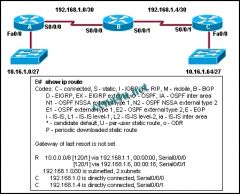
Refer to the exhibit. All routers are running RIPv1. What changes will occur in the routing table of router B if a loopback interface with an address of 10.16.1.129/27 is configured on router B?
a. Routes to the 10.16.1.0/27, 10.16.1.64/27, and 10.16.1.128/27 networks are added. b. A connected route to the 10.16.1.128/27 network is added. c. A third route to the 10.0.0.0/8 network with RIPv1 as the source is added. d. The 10.0.0.0/8 route is dropped immediately from the routing table after router B is configured. |
b. A connected route to the 10.16.1.128/27 network is added.
|
|
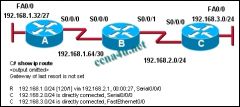
Refer to the exhibit. If all routers are running RIP version 2, why is there no route for the 192.168.1.32/27 network?
a. Rip version 2 does not send subnet masks in its updates. b. Router A is not setup with RIP as a routing protocol. c. Rip version 2 will auto summarize routes by default. d. Router B is not setup to advertise the 192.168.1.64/30 network. |
c. Rip version 2 will auto summarize routes by default.
|
|
|
RIPv2 is the configured routing protocol on the routers in a network. The command Router(config-router)# no version 2 is entered on the routers. What effect does entering this command have on routing updates?
a. Subnet masks will be added to the routing updates. b. Routing updates will be sent out using multicast address 224.0.0.9. c. Version 1 and 2 updates will be received and the version 2 updates will not be sent. d. The RIP routing process will be removed from the router and routing updates will not be forwarded. |
c. Version 1 and 2 updates will be received and the version 2 updates will not be sent.
|
|
|
How are RIP v1 and RIP v2 similar to one another? (Choose three.)
a. They both use hop count as a metric. b. They both have the same metric value for infinite distance. c. They both broadcast their updates to their neighbors. d. They both send subnet mask information in their updates. e. They both provide for authentication of update sources. f. They both use split horizon to prevent routing loops. |
a. They both use hop count as a metric.
b. They both have the same metric value for infinite distance. f. They both use split horizon to prevent routing loops. |
|
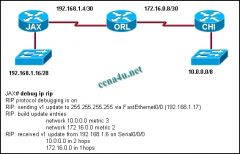
Refer to the exhibit. The exhibited network contains a mixture of Cisco and non-Cisco routers. The command debug ip rip was entered on the JAX router. All routers are running the same version of RIP. Router CHI and Router ORL are not able to reach the 192.168.1.16/28 network. What is a possible solution to this problem?
a. Enable split horizon in the network. b. Configure RIPv2 on routers. c. Add network 192.168.1.0 to the RIP configuration on the JAX router. d. Configure JAX Fa0/0 as a passive interface. e. Enable the Serial0/0/0 interface on the JAX router. f. Change the IP address on the Fa0/0 interface of the JAX router to 192.168.1.1/24. |
b. Configure RIPv2 on routers.
|
|
|
What field was added to the RIP message header by RFC 1723 to add support for VLSM and CIDR?
a. subnet mask b. destination port number c. address family identifier d. source and destination IP addresses |
a. subnet mask
|
|
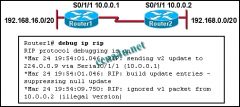
Refer to the exhibit. Which command on which router will allow Router1 to learn about the 192.168.0.0/20 network?
a. Router1(config)# ip classless b. Router1(config-router)# no passive-interface serial 0/1/1 c. Router2(config-router)# version 2 d. Router2(config-router)# neighbor 10.0.0.2 |
c. Router2(config-router)# version 2
|
|
|
Refer to the exhibit. Which two statements are true? (Choose two.)
a. Router1 will install a route to 192.168.0.0/20 b. Router1 will install a route to 192.168.0.0/24 c. Router1 will install a route to 192.168.16.0/24 d. Router2 will install a route to 192.168.16.0/24 e. Router2 will not install a route to 192.168.16.0/20 |
a. Router1 will install a route to 192.168.0.0/20
e. Router2 will not install a route to 192.168.16.0/20 |
|
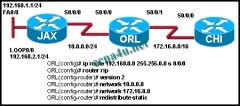
Refer to the exhibit. All routers are running RIP version 2. JAX is configured to just advertise the 10.0.0.0/24 network. CHI is configured to advertise the 172.16.0.0/16 network. A network administrator enters the commands shown in the exhibit. What changes will occur in this network?
a. The JAX router will ignore updates for the 172.16.0.0/16 network due to split horizon issues. b. The CHI router will install a route to the 192.168.0.0/16 network in its routing table. c. The routing table for CHI will have the 192.168.0.0/16 route but it will have an S next to the route. d. The ORL router will apply a 255.255.0.0 subnet mask to all networks in the routing updates it forwards. |
b. The CHI router will install a route to the 192.168.0.0/16 network in its routing table.
|
|
|
Refer to the exhibit. Which command will allow Router2 to learn about the 192.168.16.0/28 network?
a. Router1(config)# ip classless b. Router1(config-router)# network 192.168.16.0 c. Router1(config-router)# no passive-interface serial 0/1/1 d. Router2(config-router)# version 2 e. Router2(config-router)# neighbor 10.0.0.2 |
b. Router1(config-router)# network 192.168.16.0
|
|

Refer to the exhibit. Router B receives a packet with a destination address of 10.16.1.97. What will router B do?
a. drop the packet b. forward the packet via the route to 10.16.1.0 c. forward the packet via the route to 10.16.1.64 d. use the default route |
d. use the default route
|
|
|
A network is converged and the routing tables are complete. When a packet needs to be forwarded, what is the first criterion used to determine the best path in the routing table?
a. the route with the smallest AD b. the route with the longest address and mask match to the destination c. the route with the highest bandwidth d. the route with the best combination of AD and lowest cost |
b. the route with the longest address and mask match to the destination
|
|

Refer to the exhibit. Which statement correctly describes this network?
a. EIGRP is being used b. There is at least one parent and one child route c. 192.168.2.0, 192.168.3.0, and 192.168.4.0 networks are child routes d. Traffic going to 172.16.3.0 will be directed to s 0/0/1 |
b. There is at least one parent and one child route
|
|

Refer to the exhibit. Router1 has been issued the ip classless command. What happens to packets destined to host 172.16.3.10?
a. they are dropped b. sent to default gateway c. forward out interface Serial0/0/1 d. forward out interface FastEthernet 0/0 |
c. forward out interface Serial0/0/1
|
|
|
The following entry is displayed in the routing table:
R 192.168.8.0/24 [120/2] via 192.168.4.1, 00:00:26, Serial0/0/1 What type of route is this? a. a level 1 parent route b. a level 1 supernet route c. a level 1 ultimate network route d. a level 2 child route e. a level 2 ultimate child route |
c. a level 1 ultimate network route
|
|
|
What determines if the router implements a classless route lookup process?
a. Child routes are present in the routing table. b. A classless routing protocol has been configured on the router. c. The command ip classless is enabled on the router. d. Multiple routes with different masks to the same destination are in the routing table. e. Routing table entries have a next-hop IP address and an exit interface for each child route. |
c. The command ip classless is enabled on the router.
|
|

Refer to the exhibit. How many routes in this output qualify for use as ultimate routes?
a. 3 b. 4 c. 5 d. 6 e. 7 |
e. 7
|
|

Refer to the exhibit. What protocol was used to distribute the routing information for the network 172.16.1.4?
a. RIPv1 b. RIPv2 c. EIGRP d. OSPF |
b. RIPv2
|
|

Refer to the exhibit. What can be determined from this output?
a. The router will have to perform recursive lookups to forward a packet destined for 192.168.2.213/24. b. The parent route for these networks was removed from the routing table. c. A route to 192.168.0.0/25 would be classified as a supernet route for the routes listed in the routing table. d. All of the routes listed are network routes. |
d. All of the routes listed are network routes.
|
|

Refer to the exhibit. The graphic contains partial contents of the routing table on router E. Router E is running version 12.3 of the IOS and is configured for default routing behavior. Router E receives a packet to forward. Which route in the routing table will be searched first and why?
a. 172.16.1.0/25 because it is the first ultimate route b. 0.0.0.0/0 because it is the lowest network number c. 172.16.0.0/25 because it is the first level 1 route d. 172.18.0.0/15 because it has the shortest mask |
c. 172.16.0.0/25 because it is the first level 1 route
|
|
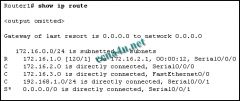
Refer to the exhibit. Router1 is running IOS version 12.2. What will the network administrator need to do so that packets for unknown child routes of 172.16.0.0/24 will not be dropped?
a. issue the ip default-network command b. use a classful routing protocol such as RIPv1 c. enable either OSPF or ISIS as the routing protocol d. issue the ip classless command e. do nothing, ip classless is on by default |
e. do nothing, ip classless is on by default
|
|

Refer to the exhibit. With the ip classless command issued, what will router R2 do with a packet destined for host 172.16.4.234?
a. drop the packet b. send packet out Serial 0/0/1 c. send packet to network 0.0.0.0 d. send packet out FastEthernet 0/0 |
b. send packet out Serial 0/0/1
|
|
|
A router has the following entries in its routing table:
S 192.168.0.0/24 [1/0] via 192.168.128.2 O 192.168.0.0/25 [110/2175] via 172.16.1.1, 00:02:15, FastEthernet0/1 D 192.168.0.0/25 [90/22455] via 172.16.2.2, 00:12:15, Serial0/0/0 R 192.168.0.0/26 [120/2] via 172.16.3.3, 00:00:15, Serial0/0/1 The router receives a packet that is destined for a host with the address 192.168.0.58. Which route would this router use to forward the packet? a. the static route b. the OSPF route c. the EIGRP route d. the RIP route |
d. the RIP route
|
|

Refer to the exhibit. What parent network will automatically be included in the routing table when the three subnets are configured on Router1?
a. 172.16.0.0/16 b. 172.16.0.0/24 c. 172.16.0.0/30 d. 172.16.1.0/16 e. 172.16.1.0/24 |
a. 172.16.0.0/16
|
|
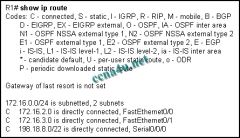
Refer to the exhibit. What subnet mask will Router1 apply to child routes of the 172.16.0.0/24 network?
a. 0.0.0.0 b. 255.255.0.0 c. 255.255.255.0 d. 255.255.255.255 |
c. 255.255.255.0
|
|
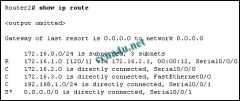
Refer to the exhibit. The network administrator has discovered that packets destined for servers on the 172.16.254.0 network are being dropped by Router2. What command should the administrator issue to ensure that these packets are sent out the gateway of last resort, Serial 0/0/1?
a. ip classless b. no ip classless c. ip default-network 0.0.0.0 d. ip default-gateway 172.16.254.1 e. ip route 0.0.0.0 0.0.0.0 Serial 0/0/1 |
a. ip classless
|
|
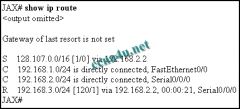
Refer to the exhibit. A packet destined for host 128.107.0.5/16 is processed by the JAX router. After finding the static route in the routing table that matches the destination network for this packet, what does the router do next?
a. searches for a default route to forward the packet b. drops the packet since the static route does not have an exit interface c. performs a recursive lookup to find the exit interface used to forward the packet d. sends a request to neighboring routers for the location of the 128.107.0.0 network |
c. performs a recursive lookup to find the exit interface used to forward the packet
|
|
|
What occurs when no ip classless is implemented on the router?
a. The router will only support classful IP addressing. b. The router will only support classful routing protocols. c. The router will use a default route, if present, when a matching route is not found in the routing table. d. The router will assume it has knowledge of all subnets in the network and will not search beyond child routes for a better match. |
d. The router will assume it has knowledge of all subnets in the network and will not search beyond child routes for a better match.
|
|
|
A route to a destination network is learned from multiple routing protocols. What is used by a Cisco router to select the preferred route to the destination that will be installed in the routing table?
a. metric b. route prefix c. update timer d. administrative distance |
d. administrative distance
|

